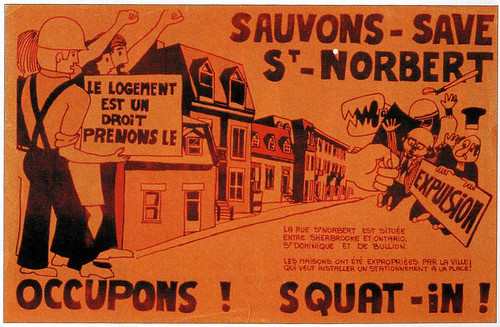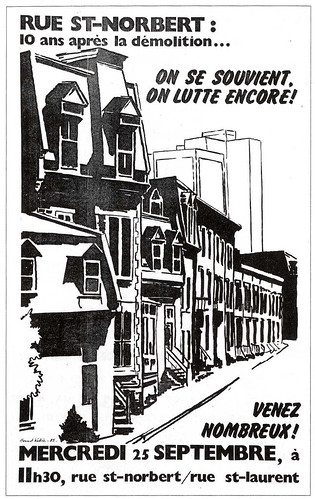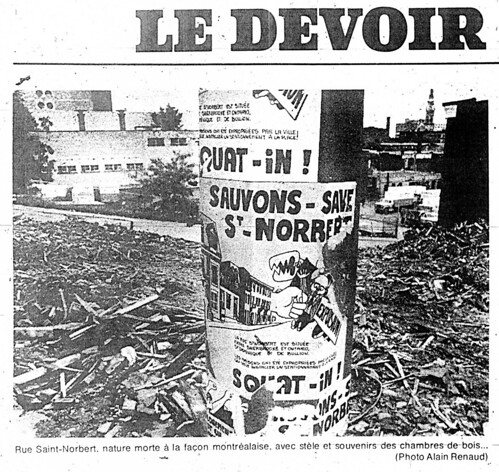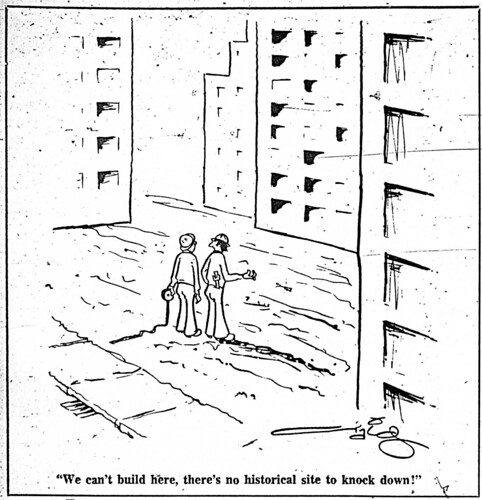My friend recently picked up a copy of the book “Picture this! Posters of Social Movements in Québec (1966-2007)“. While leafing through the pages of posters from various social causes and movements from over the last few decades, the above image caught my attention. The hand-drawn poster, with what are presumably St-Norbert residents at one side of the block of typical downtown row of houses with it’s massive human fist punching a back-hoe, a cop, and what appears to be perhaps politicians, lawyers, developers, landlords, or any combination of greedy, powerful people looking to demolish the block and put its residents on the streets. The resident’s sign beckons readers to take their right to housing and the caption at the bottom declares an occupation and a “squat-in”. The poster is credited to the Comité de citoyens de St-Norbert.
Most of the posters in the book provide no follow-up as to how successful the campaigns were or what kind of effect they had on society as a whole. It is left up to the reader to decipher, based on current conditions, what kinds of successes and failures activists of the past endured, or what fights are still being waged today. For example, posters in the book demanding better rent control may have eventually led to the very tenant-friendly regulations of the current Régie du logement and we know the results of the book’s posters from both the “oui” and “non” sides in regards to the question of independence of Quebec. The St-Norbert poster is different, however. A few pages into the book, this poster appears:
Sadly, the fight to save St-Norbert failed and activists, promising to remember and continue the fight, staged a demonstration at the site of the demolition ten years after.
When I first saw the posters, I had no idea where St-Norbert was, which is excusable, the street being a narrow quiet residential street only a few blocks long. It feels more like an alley for Ontario and Sherbrooke between St-Laurent and Hôtel de Ville than an actual street.
The first poster says that the plan was to demolish the houses and turn the block into a surface parking lot. This may well have been the case for many years but it appears that the block has recently been rebuilt with luxury condos which look to have been built sometime in the last few years:
I was curious, what happened to rue St-Norbert? Why was the block demolished? What kind of opposition did the demolitions face and what tactics were used by residents and housing activists to try to save it? To look for an answer, I turned to newspaper coverage from the day of the protest in 1985 and around the days of the demolition ten years prior in 1975. Sadly, looking through microfilms from The Montreal Star, The Gazette, Le Devoir, and La Presse, I failed to come up with much information. Perhaps I could have searched through the weeks and months leading up to the demolition in the 1975 archives but, I haven’t the time nor the ambition. What I did come up with was a photo from the September 25th edition of Le Devoir in 1975 showing the devastation of the demolition with a pole covered in posters in the foreground. The caption reads “Rue Saint-Norbert nature morte à la façon montréalaise avec stèle et souvenirs des chambres de bois…”
La Press in 1985, the day after the protest, ran the headline “Montréal n’a pas tenu ses promesses rue Saint-Norbert”. The article briefly describes how the block was just one of many casualties of the Drapeau-era demolitions and alludes to large demonstrations, arrests, and court injunctions ten years prior. Not much more detail is given.
Finally, although it is not related to St-Norbert directly, I was amused to find this cartoon in The Gazette from 1975.
So, having come up with very little about what happened concerning this small piece of Montreal history during the months and days leading up to September 25th, 1975, I turn to SpacingMontreal readers to give any insight as to what happened. Anyone who was around at the time, do you remember what happened? Was there a squat? What happened at the demonstrations and why the arrests? What was on this lot before the newly built condos? Anything that can be shared would help satisfy my curiosity and give us a bit of insight concerning urban development during those turbulent years under Mayor Drapeau.







23 comments
Ce qui s’est passé, c’est qu’une gang de pauvres, sans la moindre réalisation économique sinon que de consommer insuffisamment (je gage qu’aucun de ces pauvres n’avait même d’automobile, mais se déplacaient à vélo, véhicule de choix pour les radicaux communistes qui veulent abolir la très sainte Propriété Privée) à leur actif, se sont arrogé le «droit» de brimer un pauvre propriétaire qui voulait exercer son droit imprescriptible de faire fructifier son capital, en collaboration avec le maire d’Alors, le vieux snoreau à Drapeau qui avait toujours l’oreille attentive aux propriétaires que les sales pauvres veulent toujours brimer de l’usufruit de leur capital.
Malheureusement, depuis, la ville a sombré aux mains des infâmes communistes qui, sous Jean Doré, se sont ingéniés à éliminer toute notion de progrès économique en submergeant les promoteurs d’une quantité de processus bureaucratiques et consultatifs destinés à s’assurer que rien ne puisse être fait afin de permettre la fructification du capital réuni grâce au labeur intensif des propriétaires et spéculateurs, sous prétexte que les citoyens ont leur mot à dire sur leur ville, alors qu’on sait très bien que seuls les vaillants spéculateurs savent ce qui est bon pour tous.
I like this site but the writer here should have done a bit more work before posting this.
SAINT-NORBERT, 13 ANS PLUS TARD : UNE RUE DÉMOLIE… UN PLATEAU À VENDRE
http://bv.cdeacf.ca/EA_HTML/2004_11_0550.htm#_Toc92791046
Je me souviens de cette lutte (ce qui ne me rajeunit pas)…
Hmm, je sais que certains qui habitaient là avaient une bagnole, et que ce n’était pas forcément des militants et militantes de gauche.
C’est archi-triste. C’était une belle rue, en tout cas bien mieux que ce qu’on en a fait à sa place.
Re: “
http://bv.cdeacf.ca/EA_HTML/2004_11_0550.htm#_Toc92791046”. Thanks for that link. 30 years ago, we really were in the dark ages.
Tony: I’m not sure how much work you expect me to do for a single article written for blog for which I am only a volunteer. The post was written because I was curious as to what happened but was unable to find much information without going through months and months, perhaps years of archives. The link posted is exactly what I was hoping to get out of this post, along with personal stories of what happened which will hopefully be left here in the future.
@Jean Naimard…êtes vous sérieux ou sarcastique ?
Des rues comme St-Norbert ou Overdale démolis pour faire place à des stationnements…ca donne raison à ces pauvres que vous décriez et ca enlève toute crédibilité à vos promoteurs adorés qui démolireraient la moitié de la ville si il le pouvaient.
@Alain: merci pour le lien. Très intéressant.
-X
Ben drôle comment les répliques en français sont d’une qualité nettement inférieure à l’originale. Pourtant on est supposés à croire que le français n’est pas menacé!
Par contre je pensais que l’engouement pour le “nouveau”, le “moderne” et le “respectable” chez les peuples colonisés était bien-documenté par Fanon, parmi d’autres. D’où cette dédaigne pour les cyclistes, les vieilles maisons, les mesures d’apaisement de circulation, etc etc
Le dédain, si tu veux faire ton instit. (Le verbe est bien dédaigner, l’adj. dédaigneux). Hmmm.
Et je trouve cette analyse un peu courte: La rénovation urbain, et “HUD”, étaient une plaie aux Etats-unis au cours des années après-guerre, pas très colonisés à ce que je sache. C’est arrivé ici par la suite, avec un certain retard. Et malgré nos rudes hivers, Montréal compte parmi les villes les plus cyclables en Amérique du nord.
rénovation URBAINE, bien entendu.
“the writer here should have done a bit more work before posting this.”
What is it about this post that you object to?
The author has brought readers into the process of investigating the past, and the author has opened up a discussion;
what’s wrong with that?
Le 1er août 1975, date à laquelle la Ville de Montréal avait prévu le début des démolitions, un groupe de citoyens montréalais s’apprêtait à commencer l’occupation des 49 logements de la rue Saint-Norbert. Par ce squat politique ils voulaient empêcher la démolition de cette superbe petite rue par la Ville de Montréal. Celle-ci prétendait avoir besoin du terrain pour aménager une cour de voirie municipale entre les rues Saint-Dominique et de Bullion au sud du couvent du Bon-Pasteur. Les locataires, personnes âgées immigrantes et étudiants à faibles revenus, avaient été expulsés suite à l’expropriation de la rue.
Pendant près d’un mois, les occupants, soutenus par le Comité logement Saint-Louis et appuyés par Sauvons-Montréal, le RCM et de nombreux groupes populaires, réussirent à mobiliser l’opinion publique autour de la crise du logement et des démolitions massives effectuées par ou avec la bénédiction de l’administration Drapeau.
Durant l’occupation, on a tenu plusieurs conférences de presse et de nombreuses assemblées dans la rue. On a procédé à une rénovation symbolique des façades et à la plantation des carrés de verdure par le Mouvement Espaces Verts. Toutes sortes d’activités ont été organisées avec la participation de groupes populaires. Le groupe Le Monde à bicyclette y inaugure la première piste cyclable de l’île. Le RCM présente à l’Hôtel-de-Ville un avis de motion visant à rénover et transformer ces logements en logements publics à prix modiques. De nombreux groupes appuient les occupants dont les expropriés de Sainte-Scholastique/Mirabel. Sauvons Montréal avait demandé vainement la classification historique du Couvent du Bon-Pasteur ce qui aurait inclus la rue dans le périmètre de protection.
La Ville tient dur comme fer à son argument de la cour de voirie. Elle tente à deux reprises de fermer l’eau et l’électricité et la police arrête six occupants qui s’y opposent. Pourtant il y aura toujours au moins deux ou trois points d’eau sur la rue, car, on le saura plus tard, les cols bleus affectés à la fermeture de l’eau ne se résoudront pas à participer à l’assoiffement des squatters !
Début septembre 1975, les démolisseurs faisaient sauter les toits de 49 logements de la rue Saint-Norbert et en chassaient les derniers occupants. La Ville de Montréal mettait ainsi fin à 6 mois de lutte acharnée des locataires et du Comité logement Saint-Louis pour sauvegarder ces logements. Après la démolition, et comme l’avait prévu le Comité de lutte de la rue Saint-Norbert, la Ville n’entreprit aucun aménagement d’une cour de voirie, ce qui était prévisible vu la forte pente du terrain. Elle mit celui-ci en réserve pendant plus de vingt ans et l’on y trouve aujourd’hui des condos luxueux, comme l’avaient prédit les occupants en 1975.
Par contre, un projet similaire qui devait se faire sur les rues Lusignan et Versailles, à l’est de la Petite-Bourgogne fut abandonné par l’administration municipale qui craignait une autre mobilisation désastreuse pour son image.
Cette action s’ajouta à toutes celles qui virent des citoyens s’opposer vigoureusement et avec éclat au saccage de l’espace et du patrimoine urbain, au déracinement violent de dizaines de milliers de citoyens et à la destruction de plusieurs milieux de vie par l’administration municipale et les promoteurs immobiliers ; elle secoua l’inertie des leaders d’opinion face à l’incroyable mépris de l’administration municipale pour les citoyens et sensibilisa la population aux enjeux du développement urbain sauvage.
Ces actions directes donnèrent également des arguments à ceux qui, au sein de l’appareil municipal et dans l’opposition, voulaient imprimer une volonté de changement sur les politiques de logement et de conservation du patrimoine. Il est certain que ce puissant mouvement d’éducation populaire et d’action collective urbaine fut un des facteurs qui permirent de faire entrer l’opposition progressiste à l’Hôtel de ville et d’abattre plus tard l’odieux régime de « copains, de coquins et de requins » du parti du maire Drapeau.
Je faisais partie de ces squatters et voici le manifeste que nous avons publié au début de l’occupation:
Manifeste des occupants de la rue Saint-Norbert (août 1975)
« Nous occupons les maisons de la rue Saint-Norbert parce que la décision prise par la Ville reste injustifiée.
Nous occupons parce que nous savons qu’il existe d’autres solutions pour installer ailleurs une cour de voirie municipale.
Nous occupons parce que nous savons que la Ville préfère déporter les locataires plutôt que d’exproprier les terrains de stationnement d’ITT ou d’utiliser ses propres terrains du centre-ville.
Nous occupons parce que nous soupçonnons la Ville de dissimuler sous cette concentration de cours de voirie sur la rue St-Norbert des opérations spéculatrices avec les terrains qu’elle va ainsi libérer.
Nous occupons parce que nous savons que les maisons de la rue Saint-Norbert sont rénovables.
Nous occupons parce que nous refusons que d’autres démolitions s’ajoutent aux 30 000 logements abattus en 15 ans à Montréal et qui étaient pour la plupart des logements familiaux à prix abordables.
Nous occupons parce que pendant cette période, la Ville a construit à peine 5 000 logements publics pour reloger les locataires déplacés ou mal-logés, ce qui est ridicule face aux besoins.
Nous occupons parce que la crise du logement ainsi créée à Montréal par la spéculation de l’entreprise privée soutenue par la Ville, touche en priorité les citoyens les plus démunis et les travailleurs aux plus bas revenus.
Nous occupons parce que, compte tenu de la situation actuelle du logement à Montréal (hausses des loyers, taudis, feux, démolitions), la conservation et la rénovation de ces logements devient prioritaire et on doit y mettre le prix.
Nous occupons parce que cet ensemble d’habitation pourra représenter, après rénovation et réaménagement des alentours, un cadre de vie supérieur à tous les projets que sont capables de créer les services de la Ville et l’entreprise privée.
Nous occupons parce que la Ville est en train de commettre un crime social déguisé en progrès urbain.
Nous occupons parce que la Ville montre qu’elle est au service des développeurs et des puissances financières pour qui le logement n’est qu’une marchandise qu’on jette quand elle n’est plus rentable.
Nous occupons parce que face à l’incapacité de la Ville de répondre aux besoins prioritaires des citoyens, nous devons prendre nos responsabilités.
Nous occupons parce que nous refusons d’être déportés hors de nos quartiers.
Nous occupons parce que le logement est un droit et qu’il faut le prendre.
Nous occupons parce que ces maisons sont à nous, car nous en avons besoin. En venant s’ajouter à la lutte des expropriés des autres quartiers de Montréal, de Sainte-Scholastique et de Forillon, de Québec et de Hull, aux luttes populaires des assistés sociaux, des garderies, des femmes, des étudiants et aux luttes ouvrières des travailleurs à travers le Québec, cette lutte n’est qu’une étape dans notre combat pour que les travailleurs contrôlent un jour leurs conditions de travail, leurs conditions de vie et leur cadre de vie. »
Les locataires de la rue Saint-Norbert et le Comité logement Saint-Louis. »
I lived on St. Norbert street in the mid sixties (64-66). I have fond memories of my childhood there. I came upon your web page in my search for pictures of the old houses on the street in hope of finding mine. We lived in a triplex at 102 St. Norbert.
Our backyards faced Station 4 of the police department (now a fire station) and a clothing recycling factory. We loved the hills on De Bullion and especially the Hotel de Ville steep one where we use to ride our go carts.
I think I know why the houses were demolished. They were rat and cockroach infested. We were Portuguese immigrants at the time living in two side by side duplexes with one Russian resident. The landlord had an exterminator spray our houses and we went back in there was a carpet of dead cockroaches all over the house. There was no hot water tank and the heating system was fueled by coal back then.
I am also certain the prime location of the street high up on a hill and downtown was most likely the reason the houses were demolished to make way for the new condos there today.
My father lived on St. Norbert Street in the 1930’s, 1940’s; he was born on the street in 1934; at that time it was the “Slovak Ghetto” He lived at 82 St. Norbert street and took us up there and drove by his childhood home during the demonstrations. It was rat ridden, bat ridden and cockroached fill in his youth. The city left it as a parking lot for 12 years only due to the high resistance in the neighborhood to demolish the properties. In 1986 just 11 years after the demolition, the former reform school across the street had been gutted and re-built into condos and acclaimed as one of the most expensive condo units in the city of Montreal. The neighborhood had to be scrapped and revived. It is still going on today not a block away on St. Laurent Blvd. There is still resistance. Drapeau may not have right but Station 4 police at the base of st. Norbert new the corruption going on on De bullion St. bordering St. Norbert with the brothels, the prostitute hotel at the corner of St. Norbert and St. Domique and yet the action still happened and Drapeau was cracking down on the corruption at all levels, of course that he was not involved in. To completely tear down all that house, where over 90% of the males that had lived there back in the 30’s, 40’s and early 50’s had found to have already died due to crime related incidents, or were in prison, when a neighborhood re-union was held in September 1980 of the era my father had lived there, tells the story. Yes, it was poverty neighborhood of immigrants and like the poverty ridden neighborhood in my own district of LaSalle, the highest crime rate related to drugs, gangs, etc, and Drapeau was cracking down if he wasn’t in on the take, and that neighborhood for better or worse, had to re-locate to other areas
PS I am the president of the Canadian Slovak Business and Proffessional Assocation. All founding members were raised either on de Bullion, Hotel de Ville and/or St. Norbert Street in that district, and have plenty of stories to tell of the neighborhood at that time, and what the City of Montreal is still fighting today in what is called Montreal’s Red Light District….
Was living in third house up from rue St. Dominique, methinks, facing the Convent’s barred windowed prison on the other side of what is now infamously known as the “forgotten rue St Norbert.” Shared a second floor flat with the wondrous Patricia Mac the stripper, no relation. But literally, Pat modelled ‘nude’ for several Uni’s art classes in those daze. After all, it was the mid ’70s, yes?
Anywho, have heaps of warm memories of the era. In fact, I began my busking career which had lasted several decades, teaching our street’s Thomas, the handsome smiling long blond haired blue-eyed singing guitar picking clarinet tootin’ busking Ohio lad in his early mid 20s who often graced our street, our lives, with his splendid voice, awesome way around any stringed instrument …his banjo, uke, or mandollin, besides his six and twelve string guitar’s …and a mouth harp and I was absolutely mesmerizing to hear his clarinet. It tickled my itching feet enticing them to ‘tapdance’ and was soon asked by Thomas to teach him which I eventually did …on the low flat stoop in front of Thomas’s doorway nextdoor where I took over later in the fall of 1974 or was it 75? Regardless, eventually too, the city ordered us out, stole our homes and put us in the street with a couple hundred of bucks, but nowhere to house. Far too many of us fell through the cracks; gratefully, I’m a survivor. However, that’s but a snippet of time there, and merely one of my lives I was to live moving about in ‘la belle ville’ due to being tossed to the ‘unknown’ along with the ‘heap’ of others struggling to find shelter.
Could go on all afternoon, naming residents, telling tales and divulging secrets but I’ll suffice to say “hello” to any of the others who participated in the movement Sauvez rue St Norbert, or knew someone who did. All protesters electronic equipment during the st party was plugged into my first floor flat. Ryan Larkin playing his traps merely feet from my front window. Search him out online. Sadly Ryan’s spirit has taken flight; but he has left behind Spare Change for us all to spend time wisely. And me, his joyful long suffering ADHD conundrum pal, neil.
http://www.myspace.com/ryan_larkin/photos/370415#%7B%22ImageId%22%3A370415%7D
J’habite actuellement sur St-Norbert, dans les nouveaux condos “luxueux”. Disons que je n’étais pas né à l’époque de cette situation fâcheuse, mais je m’y suis grandement intéressé.
merci pour les infos. En passant le maire Doré habite présentement sur St-Norbert!!
Hello,
Really enjoyed your article on St Norbert. I would like to find a copy of the first picture you show of a poster printed protesting the demolition of the block .
My greatgreatGrandparents lived at 64 Fortier that later became St Norbert. 1895-96. According to Lovell’s the house would have been on the east corner of St Norbert and Cadieux (De Bullion) I would be most grateful to know of any old photos that may exist. I am making a collage and hope to depict the feeling of the street in days gone by.
I sincerely thank anyone who may be able to help.
My best, Carolyn
Carolyn, I scanned both photos of the posters from the book Picture this! Posters of Social Movements in Québec (1966-2007). I’ve seen it in quite a few independent bookstores in the city.
I lived at 80 St.Norbert Street from 1961 to 1963. Cette rue était tranquille oui mais nous étions si pauvres, pas d’eau chaude, pas de chaleur, les maisons étaient si vieilles, si mal entretenues et si mal isolées que l’hiver on gelait tout rond. I remember playing with portuguese and fighting with little english kids back then. Our flat was infested with mices and cockroaches.
C’était la misère.
Mais quand je passais par là durant mes années de jeune adulte, j’étais rassurée de voir que la rue n,avait pas changé…. Il y a trois ou quatre ans, j’ai été déçue de voir ce qu’on en avait fait à la place.
Je crois toutefois qu’il fallait que l’on jette ses taudis à terre. Il ne servait plus à rien d les conserver.
However, I don’t think that the new condos are agreable to the eye!
A photo I took in 1970 or 1971 on St. Norbert Street. The angled doorways always interested me, I have not seen them anywhere else in Montreal.
http://i191.photobucket.com/albums/z242/bobadabob/Scan.jpg
Je cherche quelqu’un qui connaissait des gens qui demeurait dans le coin dans les années 1940. Surtout une nommée Falardeau. Elle est décédé maintenant mais j’aimerais trouver une de ses connaissances.